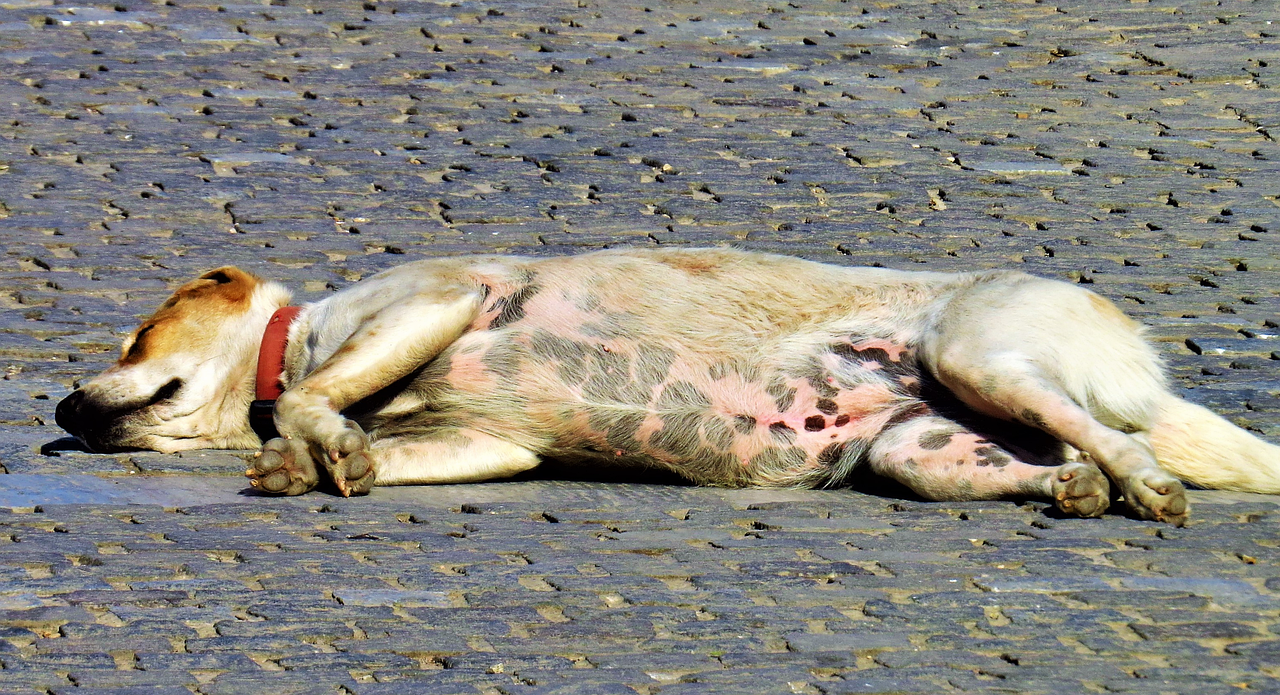If you are cuddling on your couch or giving your dog belly rubs, you notice some brown spots on his belly that look like dirt. You must be concerned and wonder what might be the problem.
There are many reasons why brown spots on the dog’s belly look like dirt. Some are secondary, while others occur naturally as a dog ages.
Mange, epidermal hamartoma, hyperpigmentation, chronic yeast infections, natural aging, fleas, and melanomas can lead to brown spots on a dog’s belly that look like dirt. Aging can also result in this problem due to exposure to UV rays. However, do not hesitate to take your dog to the vet if he has any spot that is not flat or unchanging.
Why Are There Brown Spots On Dogs Belly Looks Like Dirt
1. Yeast Infection
Dog yeast infections, also known as Malassezia dermatitis, are caused by a fungus called Malassezia pachydermatis.
Usually, the various fungus and bacteria can be controlled by your dog’s skin because of its strong immune system.
However, the bacteria and fungus on your animal’s skin could result in a yeast infection if its immune system is compromised or repressed. Additionally, if the illness is chronic, your dog may develop large, black, or gray patches on his skin.
Dogs commonly develop yeast infections. They are mostly found in wet places like the paws, ears, and groins. Your dog will show several symptoms if they have a yeast infection.
A yeast infection will undoubtedly alter the skin. The skin will initially turn pink or red. If he has ongoing infections, your dog’s skin may grow leathery and thick, turning gray, brown, or black. The skin may additionally appear greasy or oily. Additionally, some dogs can get scaly skin.
Some dogs may exhibit extremely early symptoms of yeast, which appear as tiny brown flecks around their stomachs and groin regions. These spots are sometimes mistaken as dirt, flea dirt, or aging spots. However, when these specks show, the yeast has already significantly invaded the body.
Yeast infections are not contagious. However, some dog breeds are more likely to develop it than others. Dachshunds, Silky Terriers, Cocker Spaniels, Australian Terriers, and Chihuahuas are a few of them.
2. Hyperpigmentation
A dog’s body will produce hyper pigment in response to specific circumstances. As a result of this reaction, the skin becomes thicker and darker. It typically happens on the skin without hair, such as a dog’s belly. The two types of hyperpigmentation are primary and secondary.
Hyperpigmentation has four main symptoms.
- First is the skin’s discoloration, which ranges from light brown to black.
- Second, there’s a chance that the affected area’s skin will thicken, turn velvety or rough, and lose hair.
- Third, specific regions such as the armpits, groin, and legs are frequently impacted.
- Lastly, the regions around the edges of the hyperpigmentation may appear red due to secondary yeast infection.
Primary hyperpigmentation is uncommon. Since it most frequently affects Dachshunds, it is believed to be breed-specific. It is most noticeable by the time a dog is a year old.
This condition cannot be cured. While some dogs have a minor issue that doesn’t require treatment, other dogs may require medicated shampoo or steroids.
All dog breeds show secondary hyperpigmentation to varying degrees. The disorder may be brought on by obesity, hormone imbalances, allergies, contact dermatitis, and skin infections.
3. Mange
There are two types of mange: sarcoptic mange and demodectic mange, both of which are caused by mites.
The same species of mite that causes scabies in people, Sarcoptes scabiei, is the source of sarcoptic mange. These minuscule, spider-like mites itch badly by penetrating the skin deeply. They are known to target non-furry areas like the armpits and belly.
Excess licking and itching cause red rashes, which could later develop into dark spots and fur loss.
Demodectic mange is brought on by Demodex mites and results in intense licking, itching, and open sores that may develop into dark areas. It mostly affects dogs with weakened immune systems and is not contagious.
4. Aging
Age spots might appear on your dog. A dog is still vulnerable to the sun’s UV rays even though he has a fur coat. His coat’s thinner patches like belly and nose are more vulnerable to sun exposure hence the development of age spots.
An overproduction of melanin in the skin results in age spots. Pigmentation is brought on by melanin.
5. Fleas dirt
One of the most certain signs that your dog has fleas is flea dirt. It appears dark, with reddish-brown dirt flecks. It normally appears on a dog’s abdomen near his hind legs.
When you locate flea dirt, you can be certain that you will have an infestation even though you cannot see any fleas. To keep your dog healthy, you need to take measures to ensure your home is flea free.
6. Flea Allergy Dermatitis
Flea bites cause this illness. A flea injects its saliva into the skin of your dog while sucking blood.
The saliva of a flea contains peptides, amino acids, and other substances that resemble histamine and may cause an allergic reaction in your dog’s immune system. In addition, it might make your dog’s skin terribly irritable, causing excessive licking, rubbing, and scratching, leading to sores that later develop into dark patches.
Malignant melanoma is one of the frequent skin cancers in canines. These tumors frequently develop on the lips, mouth, and nail beds.
7. Melanomas
Malignant melanomas resemble elevated tumors that are frequently ulcerated and pigmented. They can sometimes appear gray or pink inside the mouth. They manifest as toe swelling, loss of the toenail, and deterioration of the underlying bone when they are in the nailbed. Secondary infections are known to form in nailbed tumors, which frequently causes them to be misdiagnosed.
Benign melanomas can range in size from being extremely microscopic to being more than 2.5 inches. They normally appear on skin places that have hair covering them. They come in various colors, like black, gray, red, and brown.
My Dog Has Brown Spots On Belly That Looks Like Dirt. What. What Should I Do?
When you see dark spots on your dog’s belly or any other place, the first step is to call your vet. Even though these spots can be a sign of aging, they might result from underlying conditions. So, a vet will help determine the root cause.
Unfortunately, it is incurable if your dog is suffering from primary hyperpigmentation. However, it is manageable if noticed in the early stages.
Once the cause is found, treating secondary hyperpigmentation is easy. For instance, yeast infections can be treated with antibiotics and antifungal drugs. In addition, other skin conditions caused by flea dermatitis can be managed with medicated shampoos to relieve itching.

